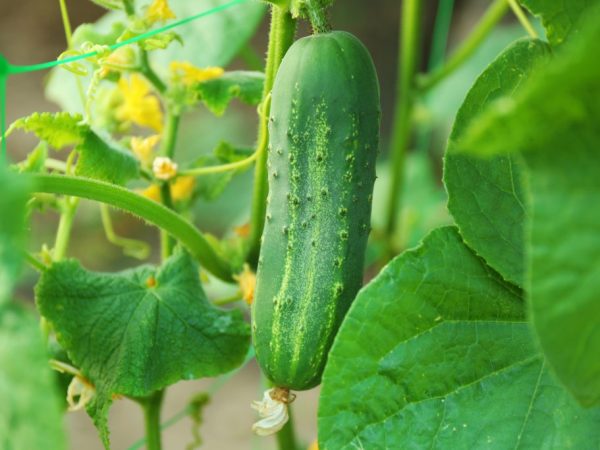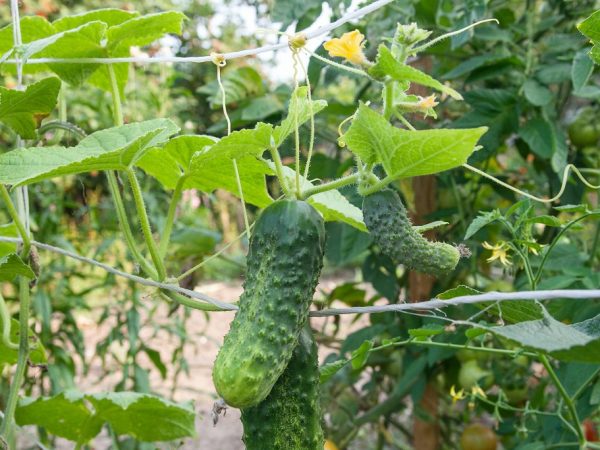Description of a cucumber variety Competitor
Despite the fact that the competitive cucumber does not belong to self-pollinated crops, it has high characteristics of taste and yield. In addition, gardeners love this variety for its early ripening time, which is very important for vegetable sellers.

Description of Competitor cucumber
Characteristics of the variety
This species appeared a long time ago, back in the middle of the 20th century. They produced him in the Crimea. Just a few years later, in 1980, it was entered into the National Register of the Russian Federation.
It is believed to be ideal for cultivation in all regions of the country. Also, cultivation is possible in open ground and in film conditions, for some time.
Description of the plant
The bush of this variety has rather high characteristics. The height of the bush can reach about 2 m. Lateral branches are formed by an average amount. The main stem is considered to be the longest. The stalk reaches a height of 7 cm, which is ideal for harvesting.
The bush should be formed into 1 stem. To do this, it is important to remove all lateral ovaries and stepsons in the first 3 nodes. These measures allow you to make the plant more green and better form the root system. The foliage is quite dark and has a slight ribbing at the ends.
Description of the fetus
The fruits are cylindrical in shape, with a small oval at the ends. Small ribbing and large tubercles are formed on the surface. The bumps have dark shades on the surface. The size of the fruit itself is relatively small. The length of one fruit is about 12 cm, but the weight is 100 g.
The description suggests that the surface skin of the fruit can vary from light green to dark green. You can also see small white stripes that only extend to the middle of the cucumber. There is also a small edge.
The pulp is firm and has little crunching characteristics. These fruits are characterized by the aroma that is inherent in a large number of varieties of cucumbers. The yield is satisfactory and amounts to 4 kg per 1 m2. Also, these cucumbers are considered versatile. They are suitable not only for fresh consumption, but also for preservation and pickles. It is in pickled form that the best taste qualities of cucumbers of this type are manifested.
Advantages and disadvantages
If we consider the description of this type of cucumber, then farmers can highlight the following positive qualities of the variety:
- high taste indicators;
- versatility in application and preparation;
- resistance to a large number of common diseases that relate to cucumbers;
- possibility of transportation over long distances and preservation of commercial qualities.

The variety is resistant to most diseases
The disadvantage of these cucumbers is the fact that they quickly start to taste bitter if they lack moisture.It should also be noted a nuance, which consists in the rapid yellowing of cucumbers, if not to harvest on time.
Growing
In principle, Competitor f1 cucumbers are not particularly demanding on the soil. They can produce amazing fruit quality if all planting rules are followed. First, Competitor f1 seeds should only be selected that are of medium size. Seeds will have to be bought every year, because the seed material is reborn and cannot be used for subsequent plantings.
Secondly, the crop should be planted at a certain distance. A distance of 40 cm should be adhered to between the rows. This distance should be observed between the holes. It is important to remember that the seeds must be prepared. They must be treated with special growth stimulants to improve germination. Planting a plant or seed in open ground begins at the end of April. It is important to wait until the soil warms up after the winter frost. Ideally, if its temperature reaches 20 ° C, because this will allow the root system to develop much better and faster.
If all of the above conditions are met, then the first shoots are observed in a week. Moreover, when planting 2-3 seeds in one hole, germination is one hundred percent. It is especially important that the soil has a high concentration of humus. It promotes rapid growth and quality of the bush.
How to care for
In order for the plant to grow quickly and efficiently, it needs special care. The cultivation of ideal fruits is achieved only after all conditions are met. Firstly, you should regularly loosen the soil and carry out hilling of open areas of the root system. Secondly, regular and correct watering is important. Thirdly, weeding the ridges from weeds and regular feeding of the root system is important.
Not only mineral fertilizers are introduced into the soil, but also organic ones. The use of humus and wood ash allows the root system to compact and develop more properly. Biohumus or components of potassium or phosphorus can be used as organic feeding. Top dressing should be done in 2 stages. The first is carried out at the moment when flowering is just beginning. The second feeding is carried out at the moment when flowering budding occurs.
Watering is carried out only in the evening and only with water at room temperature. It is best to use drip irrigation, which irrigates the garden much more efficiently.
Preventive measures
Cucumber Competitor F1 has a high resistance to most diseases. It is not affected by diseases such as cucumber mosaic, aphid infestation or spotting. Also, this species is not affected by bacteriosis and fungal diseases.
This advantage should not affect the bawdy attitude towards this species. Indeed, situations may occur when the disease progresses and still affects the plant. Therefore, a visual inspection of the bush for the presence of all sorts of diseases should be carried out in a timely manner. As soon as strange factors have been identified, disinfection should be carried out immediately. We have our own chemicals to fight each disease. For example, copper-containing substances are used to combat aphids. From mosaic and spotting, a category of substances that contain a high concentration of potassium is used.
Conclusion
Growing this culture requires certain care kits. If you believe in the reviews of experienced gardeners, then this variety should be grown only using trellises for tying. In the early stages of development, it was assumed that Competitor f1 can only grow on chernozem soils. But, after some innovations, it can now be grown on any fertile soil.


